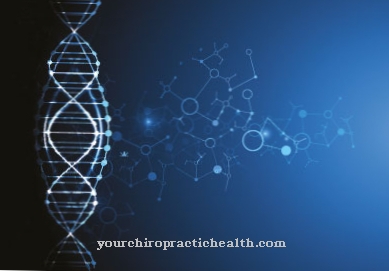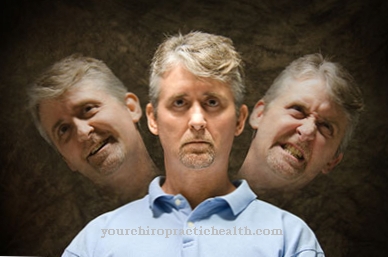Of the Antithrombin deficiency is a congenital hereditary disease. It increases the likelihood of thrombosis occurring. The deficiency also causes a reduction in concentration and activity.
What is antithrombin deficiency?

© metamorworks - stock.adobe.com
The congenital antithrombin deficiency was first described by Olav Egeberg in 1965. Antithrombin is a glycoprotein that has an inhibitory effect on blood clotting. It is made in the liver and is part of the blood plasma. 55 percent of the blood consists of blood plasma. It contains the non-cellular parts of the blood.
The main task of the plasma is to transport the cellular blood components. The lack of antithrombin in the blood plasma means that there is an increased risk of thrombophilia. This means that the blood coagulability is increased. In addition, the risk of thromboembolism increases. As soon as additional risk factors such as an operation or an accident are present, the sick person consequently develops a thrombosis.
A blood clot forms in the blood vessel. This acts like a blood clot and clogs or hinders the flow of blood. The clot of blood is called a thrombus. It can also form in the heart and stop the blood flow there. The clot can develop in any artery in the entire bloodstream and block the blood there. This creates the risk of a heart attack or stroke.
causes
The cause of the antithrombin deficiency goes back to a hereditary gene mutation. Antithrombin deficiency is a congenital hereditary disease that is inherited as an autosomal dominant trait. Due to the dominant inheritance of the disease, the existing genetic defect is automatically passed on to the child from at least one parent. As a result, once the mutated gene is present in a parent, there is no way to prevent the antithrombin deficiency from being present.
The characteristics of the dominant allele prevail over a recessive allele during the development phase of the embryo. As a result, the child is born with an antithrombin deficiency. However, abnormalities or an immediate need for medical action are not to be expected immediately after the birth.
However, this changes after the first decade of life. Thrombosis has been diagnosed in around 80 percent of patients before the age of 40. The antithrombin deficiency is caused by mutations in the SERPINC1 gene. This is located in the hereditary line on chromosome 1 (1q23-q25.1).
Symptoms, ailments & signs
Due to the congenital genetic defect, there has been a deficiency of antithrombin in the blood since the beginning of life. Therefore, in theory, thrombosis can develop immediately after birth. Patients suffer from deep vein thrombosis. Often the etiology cannot be finally clarified. A sign of the protein dysfunction may be poor sleep.
An incipient thrombosis is not necessarily associated with symptoms in the first stage. The signs of an existing thrombosis depend on the affected part of the body in which it occurs. Signs are often only clearly noticeable on the legs. There is a feeling of tension or heaviness in the limbs. The skin usually feels warmer in the affected area. Their color changes to a reddish or bluish color.
In addition, it shines a little. Some patients report pulling pain. The symptoms are similar to those of sore muscles. Since the overall activity of the blood is reduced due to the lack of antithrombin, numbness in the fingertips or toes is documented in sick people. In these areas they are more sensitive to the effects of cold.
Diagnosis & course
The diagnosis is made after a venous blood sample is drawn. As soon as the patient appears with a conspicuously frequent thrombosis, a blood test is carried out to provide clarity. An antithrombin deficiency leads to lifelong recurrent thromboembolism. The intervals between the recurrence are variable and depend on other factors.
When should you go to the doctor?
As a rule, most people have an antithrombin deficiency due to a genetic defect immediately after birth and is therefore recognized very early on. Those affected show vein thromboses that are relatively severe. If the antithrombin deficiency has not yet been diagnosed, a doctor should be consulted if the thrombosis is clearly visible or if the patient is sleep deprived.
Not infrequently, the antithrombin deficiency also leads to heavy extremities, so that there may be restrictions in movement. The skin on the affected areas can also be very warm and in some cases painful. A bluish or reddish coloration of the affected area can also be a sign of the antithrombin deficiency. A doctor should also be consulted if numbness or muscle soreness occurs even though no particular activity or exertion has been performed. In most cases, differences in temperature are also more noticeable in the affected areas.
As a rule, the diagnosis of antithrombin deficiency can be made by a general practitioner. Further treatment is usually carried out by an orthopedic surgeon.
Doctors & therapists in your area
Treatment & Therapy
Since the antithrombin deficiency is based on a genetic defect, it cannot be treated directly. If the patient has not had any symptoms so far, he does not need permanent medication.However, he receives an explanation of the risks. The treatment of the deficiency in the body's own anticoagulants is carried out by administering medication.
Their effect is aimed at reducing blood clotting. Its content is a vitamin K antagonist. After a thrombosis, a patient suffering from the antithrombin deficiency is permanently discontinued. This is to reduce the recurring risk of thrombosis.
It is recommended that women discontinue ovulation inhibitors such as birth control pills or other estrogen supplements. Therapy options for addiction relief are offered to smokers. In the further course of therapy, the patient and their close relatives are trained in the administration of heparin injections. These significantly reduce the incidence of thrombosis.
Outlook & forecast
Since the antithrombin deficiency is a congenital disease, there is no chance of permanent relief or cure without medical care. In the natural healing process, no changes in the deficiency symptoms are to be expected. The genetic defect cannot be cured by administering medication or surgery. An intervention in the genetics of humans is not permitted according to the current scientific possibilities and legal conditions.
Nevertheless, there is a possibility that the patient will not show any symptoms or impairments in the course of his life. A symptom-free life is possible with the antithrombin deficiency. After the diagnosis, the treatment plan provides for a comprehensive explanation of the patient's health and the first signs of a health problem. If these instructions are observed, there is a very good chance of alleviating the existing symptoms and preventing and curing a thrombosis.
At the first sign of a discrepancy, blood coagulants are taken. The drug has a rapid effect, so that it usually heals within a few days or weeks. Long-term medication can be used to prevent thrombosis. Depending on the circumstances, this can take place over months or several years.
prevention
The sick person is adequately informed about the disease and usually receives heparin injections in order to be able to carry out first aid in the event of a thrombosis. Other preventive measures include avoiding long periods of standing or sitting. A sufficient amount of fluid should always be consumed. The diet should be balanced and smoking avoided.
Contraceptives should be avoided whenever possible. It is important to make sure that the veins are not constricted. This happens when the knees are bent sharply or the legs are crossed for a long time. It is advisable to wear compression stockings on long journeys or after operations.
Aftercare
The antithrombin deficiency is due to a genetic defect. This is not curable. Patients have to deal with the disease for a lifetime. This means that the focus of follow-up care cannot be to prevent the cause from recurring. Rather, it is about spending everyday life largely symptom-free and without complications.
A blood test provides clarity about the presence of the antithrombin deficiency. Medicines that reduce blood clotting are suitable to alleviate the typical symptoms. Patients are responsible for taking prescribed funds. If necessary, the dosage will be adjusted after consulting a doctor.
Everyday life holds various risks in store for those affected. You are responsible for taking preventive measures. Standing and sitting for long periods of time in particular can lead to the known symptoms. Private and professional life must be adjusted accordingly. Elaborate journeys are particularly dangerous, as they are usually made while sitting. Thrombosis socks prevent the formation of blood clots.
It is scientifically recognized that smoking promotes the antithrombin deficiency just as much as a one-sided diet. Sufficient fluid intake has a positive effect on the course of the hereditary disease. Women should make sure that taking birth control pills increases the risk of thrombosis. If necessary, a gynecologist can suggest alternatives to contraception.
You can do that yourself
In the case of antithrombin deficiency, the person affected should reconsider behavior and lifestyle choices that promote the formation of a thrombus. Smoking or comparable stimulants must be avoided in principle. In addition, you should not adopt any postures in which blood vessels can be constricted.
Sitting in positions in which little movement is possible or a rigid posture that is taken for several hours are also not conducive to maintaining your own health. The blood builds up and can quickly lead to the formation of a thrombus.
Before taking certain medications or choosing the right contraception method, individual side effects should be considered. For example, taking birth control pills increases the risk of developing a thrombosis. In the case of an antithrombin deficiency, sufficient and regular movements and a well-functioning circulatory system are helpful. The blood circulation can be stimulated independently by various training units within a short time.
Wearing thrombosis stockings on long journeys by car, train or plane prevents blood clots from forming. At the same time, you should avoid clothing or accessories that could cause blood congestion. The person affected can ensure that they are supplied with sufficient fluids in everyday life. Adults should drink two liters a day during normal exertion and outside of a heat wave.



.jpg)




















.jpg)



